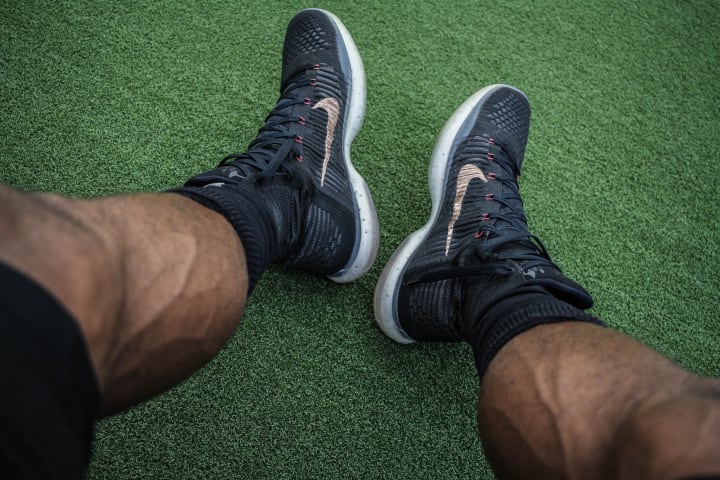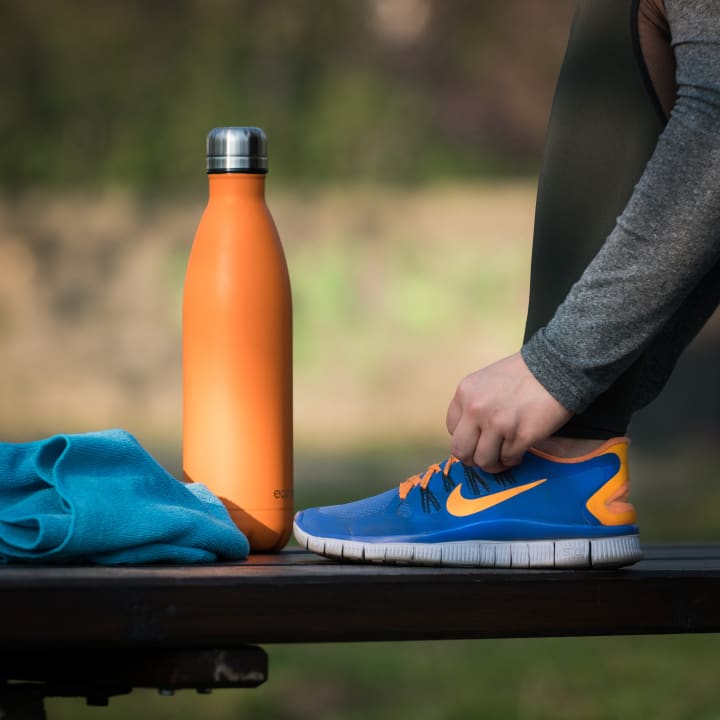5 Tips to Run Faster and Avoid Shin Splints
Shin splints are one of the biggest headaches for runners of any age. Here’s what I’ve learned to help prevent and treat shin splints.

As someone with firsthand experience, I can confirm that shin splints are a huge pain both physically and figuratively. When I began running track in high school, shin splints were the number one biggest complaint from my peers and the most common reason for my teammates to sit out of practices and meets. I assumed that shin splints were an inevitable reality of being an athlete, so I never thought about ways to avoid them. When I first got shin splints in my sophomore year of high school, I realized just how disruptive they are and how much of a damper they can put not just on an athlete’s career, but in all aspects of life. So I set out to do some research and see what I could do to prevent ever having to deal with shin splints again, and I’m going to share what I know with you today.
As a quick point of clarification, runners and other athletes frequently use the term “shin splints” to refer to many types of lower leg pain. Medically speaking, there is no specific diagnosis for shin splints. The term can actually refer to any of a handful of lower leg conditions with varying levels of severity, from simple muscle strain to stress fractures to rarer, more severe conditions. However, the techniques for avoiding these various ailments are largely the same. When it comes down to it, all you need to run faster and avoid shin splints is to exercise the smart way, with the right techniques and mindset.
Work Smarter, Not Harder

In simplest terms, shin splints are an overuse injury. This means that newer runners are especially susceptible to shin splints if they increase their mileage or intensity too rapidly. While it’s admirable for a young runner to endure a long run at the start of their first season, it’s dangerous to over-exert yourself and risk taking time off due to injury. You can’t improve as a runner when you’re on the bench recovering!
I learned this lesson the hard way my first year of running track. I didn’t want to seem lazy or wimpy, so I pushed myself beyond my limits on a daily basis during practice. Instead of earning a spot on the varsity team in my first year, my misguided efforts found me sitting on the sidelines of what should have been my first big meet. Now, knowing your limits and stretching them in a measured way is one of the only ways to improve your abilities. The thing is, young runners may not understand enough about their limits to thoughtfully push past them.
There’s no shame in taking it easy, especially if you’re new to the sport. Rookie runners should really only be running every other day. Even experienced runners should take at least one day off every week. It’s not lazy to take a breather! Just think about it this way: pushing yourself too far today means you’ll have to take extended time off before you can get back on the proverbial horse, rendering that effort for naught. Working smarter, rather than harder, means you can increase your efforts bit by bit over the course of a season. In two months’ time, the conscientious young runner will have built up considerable endurance and speed, whereas the foolhardy runner is sitting out another track meet due to shin splints.
Stretch

When it comes to the “work smarter, not harder” adage, stretching is just about the smartest thing you can do as a runner trying to avoid injuries like shin splints. Knowing how and when to stretch is half the battle when it comes to avoiding overuse injuries like shin splints. Stretching is standard practice for just about all athletes, but too many go about it without actually thinking about what they’re doing. An ill-informed stretching routine can do more harm than good, so it’s of the utmost importance to put proper consideration into the activity.
The first and most important rule of stretching is don’t stretch cold. You have to wake your muscles up before seriously stretching them. It is far better to stretch after your run than before it. Sprinters should take a warm-up jog and do a light stretch before working on speed. When you stretch, take your time, ease into positions, and don’t force anything. Stretch each leg two or three times, and hold each stretch for a good thirty seconds or so.
There are countless varying stretching techniques, so my best advice is to find what works for you, but make sure you’re not neglecting any muscles. A proper stretching session should last a good ten or fifteen minutes. If it only takes you three minutes to stretch, it is time to seriously reevaluate. Poor stretching habits lead to overworked and undertreated muscles, and overworked muscles lead to injuries like shin splints.
Get New Shoes or Add Orthotics

If you’ve tried all the other tips and tricks in this list but are still struggling to get your shin splints under control, it’s probably time for an equipment check. Poorly-fitting or under-engineered shoes can provide too much wiggle room for your feet. There is a natural side-to-side movement in your feet and ankles when you walk called pronation. The increased force of running can lead to excessive pronation. In other words, your feet start to roll inward as they strike the ground. This can put a lot of undue strain on your lower leg, which can easily lead to injuries like shin splints.
Leg-strengthening exercises can help avoid shin splints in the general sense, but there’s not really an easy “anti-pronation” exercise regimen. Instead, I recommend reevaluating your footwear. Runners go through shoes fast enough that we get many opportunities to try different models until we find the perfect fit. The perfect running shoe is lightweight but well-constructed and secure enough to prevent excessive foot and ankle movement. The perfect running shoe also... doesn’t really exist. Even if they seem perfect, they’re not customized to your specific needs, and even the features you like most about the shoes, whether it’s the support level or the shape of the soles, can change as they wear.
In my case, it was always my unusual shoe size (12.5) that seriously limited my options. It’s for this reason that I advocate orthotics as a solution for many runners. There are countless options on the market with varying degrees of effectiveness, but I personally recommend investing in high performance insoles that let you customize them to your body type and activity level. My favorites that I’ve found so far are from VKTRY. These full length carbon fiber insoles provide added bounce and shock absorption which can significantly reduce the problems of shin splints. Not only can they help prevent injury, you’ll be amazed how much your performance improves with the right equipment.
Don’t Skip Leg Day

A lot of runners might be under the misconception that running activities are all you need to build leg muscle. The reality, however, is that incorporating specific leg-strengthening exercises into your routine can greatly improve your performance. One 2009 study concluded that larger, stronger calf muscles can help prevent injuries like shin splints and stress fractures. After my first encounter with shin splints, I added several leg exercises to my routine, focusing especially on my calves.
There are countless leg exercises that can help you avoid injury, most of which don’t even require any special equipment. One of my favorites is a simple calf raise: stand up straight with your feet slightly apart and lift up your heels so that you’re standing on your tiptoes. Hold for a couple seconds and repeat 10-20 times. This exercise stretches your calf muscles while building muscle and improving balance, and it can be modified in a number of ways. Try standing on a step with your heels hanging off the edge. This way, you can lower your heels as well as lift them. A step also makes it easier to work on one leg at a time.
Adding an exercise like calf raises to your routine only adds a minute or two to your workout, but that time will soon add up to significant gains in your running performance while helping to reduce your risk of shin splints or other serious injuries.
Recovery

No matter how hard you try to avoid them, every athlete has to deal with injuries at some point. Even with the right footwear, stretching, and pacing techniques, some runners will still have to deal with leg issues like shin splints. Once you have an injury, the name of the game is no longer prevention: it’s treatment. Like with most muscle injuries, ice is your best friend in dealing with shin splints. Ice your leg regularly for as long as it takes for the pain to subside. Using a foam roller and other self-massage techniques will help ease the tension in the affected muscles as well.
The golden rule of recovery is to actually let your body recover! Nobody has ever cured their shin splints by continuing to run every day. Take as long as you need to ensure your legs are healed before putting any strain on them. Going back to my “smarter, not harder” advice, there is no shame in taking the time to let your legs heal.
If you try and rush the healing process, all you’ll be doing is risking further and potentially permanent damage. That said, there are a number of ways you can remain active without compromising your legs’ healing process. In my case, I became well-acquainted with my high school’s pool during my time with shin splints. Swimming is an excellent way to get a cardio workout and build your core muscles without putting a huge strain on your leg muscles. Because of the low-impact environment, the pool is a great place to wait out your recovery without feeling like you’re wasting your time.
Depending on the severity of your injury, you could be icing your leg and working out in the pool anywhere from a few days to a few weeks. Once again, I implore you not to rush this process. Once you’re up for your first post-recovery run, it’s important to pace yourself. Start with shorter, lighter jogs and allow time for yourself to rest and stretch properly. I know it’s hard to restrain yourself, especially if you’re naturally impatient like I am, but I promise if you take your time, explore your options with equipment, and ease back into running with these new techniques, you’ll be back and better than ever in no time.
About the Creator
Brad Gould
I’m a sports nerd that has multiple fantasy teams in every sport. If you want to know who won the championship in any major sport in any year you’ve come to the right place.







Comments
There are no comments for this story
Be the first to respond and start the conversation.